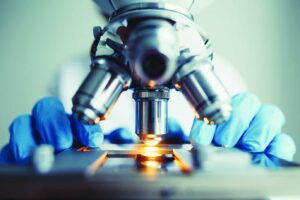Total employment in the Massachusetts life sciences industry remained effectively flat in 2024, a noteworthy slowdown for a cornerstone sector after more than a decade of steady growth.
A new report published Tuesday by the Massachusetts Biotechnology Education Foundation estimated the Bay State had 143,142 life sciences jobs last year across various employers, an increase of about 0.02 percent over 2023.
That change is by far the smallest year-over-year growth in the last decade and a half for the industry, which policymakers view as so important to the state’s economy that it forms one half of the famous “meds and eds” catchphrase.
In every other year from 2011 to 2023, life sciences employment increased between 1.62 percent and 9.18 percent according to data shared with the News Service.
Slowdown Impacts Real Estate
MassBioEd CEO Sunny Schwartz said the one-year flattening is “not a cause for concern,” pointing to prior “ebbs and flows” in workforce trends over the years.
“The industry, just like every industry, is conservative on their hiring,” Schwartz said in an interview. “2024 was an uncertain year with a big election coming up in the fall, so I think the companies took a conservative approach ahead of that consequential election.”
One factor, Schwartz said, could be lingering pandemic effects. She described 2021 and 2022 as “high-growth years” – 6.8 percent and 9.2 percent employment increases, respectively – and said some employers might have pursued a “correction” after overhiring.
“We’ve heard a lot about layoffs in this industry from some big companies, and what’s interesting is that with that, you would have expected the employment to go down, but it didn’t,” Schwartz said. “It remained flat, which means that other companies are hiring.”
But the slowdown in hiring is meaningful for owners of buildings designed for life science firms, many of whom have no tenants at all after betting on continued explosive growth in the biotech industry that came to a sudden halt in 2022 and 2023.
Fully one quarter of all lab space in Greater Boston, alone, is vacant right now according to first-quarter research by commercial brokerage CBRE. Even the industry’s heart has an 11.7 percent vacancy rate, and experts suggest the pace of leasing may not be enough to sustain large, nearly-empty buildings in peripheral leasing submarkets.
Industry Still Outperformed Other Sectors
The longer-term trend still reflects sizable growth during a period in which Beacon Hill steered billions of dollars toward the life sciences industry. From 2010 to 2024, total employment in the Massachusetts sector soared nearly 80 percent, from just shy of 80,000 workers to about 143,000.
The report, based on research by Teconomy Partners LLC, also said the industry here has outperformed the state economy as a whole as well as national rates of growth. Between 2022 and 2024, employment in the Bay State’s life sciences sector grew 4.2 percent, compared to 1.1 percent employment growth in life sciences companies across the country.
MassBioEd, a workforce development and education nonprofit, publishes an assessment of industry employment each year. The organization hosts its 10th annual Life Science Workforce Conference on Tuesday, featuring remarks from Schwartz, Mass. Life Sciences Center President and CEO Kirk Taylor, Executive Office of Education Assistant Secretary for Career Education Robert LePage and Rep. Ted Phillips.
The mix of employers has changed over the past decade and a half. In 2010, about 60 percent of life sciences jobs were at biopharmaceutical companies; by 2024, that share rose to nearly 74 percent. Over the same span, the share of industry jobs at colleges and universities, hospitals, and medical devices and equipment companies dropped.
Schwartz said the outlook in 2025 is “uncertain,” especially with significant federal funding shifts that remain tied up in court battles.
The Trump administration’s attempts to cut National Institutes of Health funding could hit Massachusetts especially hard. Schwartz said the Bay State “is the largest recipient of NIH funding in the country, so any reduction to that would be definitely a challenge to our local ecosystem.”
The Legislature and Gov. Maura Healey last year reauthorized $500 million in state borrowing over 10 years for the Life Sciences Initiative first launched under Gov. Deval Patrick, and they also boosted the annual life sciences tax incentive program from $30 million to $40 million.







